Recommended Varieties/Cultivars
Gardeners and cooks seem to agree that leaves of Italian or flat-leaf varieties of parsley are generally more fragrant and flavorful, and better for culinary use and drying, than curly varieties, which may be milder or in some cases, bitter, and are more often preferred for garnishes.
Parsley is somewhat more heat tolerant than many cold-season herbs and greens, and will often last longer into late spring or summer in hot inland valleys. Italian flat-leafed varieties tend to be more heat tolerant than curly varieties.
Italian and flat-leaf varieties of parsley are sold as Italian Parsley or Italian Flat Leaf Parsley. Flavor, size, and other characteristics may vary for seeds sold under these names. One of the best home-garden varieties, variably called Giant of Italy, Italian Giant, Gigante Italian, or Gigante D'Italia, produces large, flavorful leaves that are ideal for fresh cooking. For drying and use as a culinary spice, try Dark Green Italian.
For curly varieties, GardenZeus recommends Triple Curled, which is fast-growing and tolerant of both cold and heat. Moss Curled is double curled with ruffled leaves and has a milder flavor than flatleaf types. Sweet Curly has a milder flavor that some consider sweet or even nutty.
Root parsley is also called Hamburg, German, or turnip-rooted parsley. The root is cooked into soups and stews, or eaten fresh, like carrots. In recent years it has been more popular in Central and Eastern Europe than in the United States. Root parsley looks similar to a parsnip and has a unique taste, like a strongly aromatic cross between parsley and celery, with maybe a bit of carrot. Root parsley seed varieties available in the United States include Hamburg Rooted, Arat, and Hamburg Half Long.
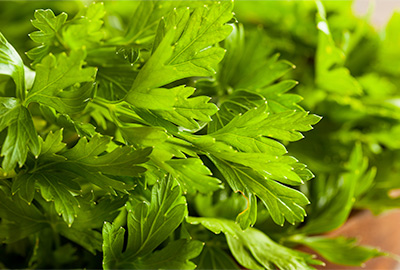 Flat leaf parsley" />
Flat leaf parsley" />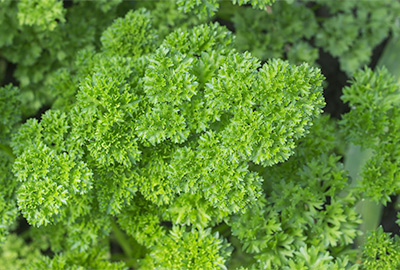
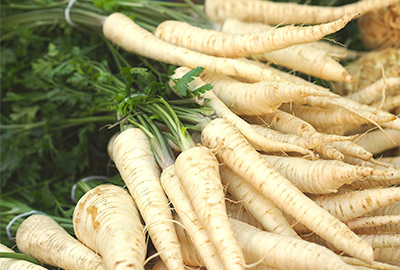
Buying/Selection Tips
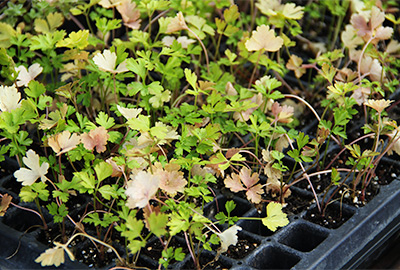
Parsley’s potentially long germination period, often 2 to 6 weeks, the need for seeds to remain consistently moist for good germination, and its slow growth at the seedling stage can make it difficult to succeed when seeding directly outdoors. You may want to avoid the hassle of seeding directly by purchasing transplants or starting seeds indoors, where it’s easier to control temperatures and maintain soil moisture.
Unlike many garden vegetables, parsley transplants reasonably well, and GardenZeus recommends that new or inexperienced gardeners try parsley for the first time with transplants; however, beware of rootbound parsley starts! When buying starts, tap the pots, cells, or containers to loosen the rootballs and look at roots. Some visible roots, a freckling of white roots at the edges of rootballs, or a fine net of roots are acceptable; overgrown, circling, or layered roots at pot edges and bottoms are not, and may result in slow-growing, stunted, or stressed plants. Smaller parsley starts of 1.5 to 2.5 inches tall may be less rootbound and may outperform larger starts after transplant. Inspect seedlings before purchasing to be sure that foliage is healthy and free of disease.
Save yourself money: Growing parsley is significantly cheaper than buying bunches of parsley from the grocery store or farmers’ markets, and growing herbs in general typically results in greater savings than growing vegetables.
Soil Needs/Tip
Parsley prefers loose, reasonably fertile, moist-but-well-drained soil with an acidic pH in the range of 6.0 to 6.5, and with moderate to high organic matter, but will tolerate many soils and pH from 5.8 to 7.0.
Parsley grows reasonably well in the clay soils that are common in many areas of California as long as soils are not too compacted, and alkalinity and salinity are not too high. If faced with tough clay soils in your yard or garden, you may do best growing parsley in raised beds or containers.
Suitable Microclimate
Ideal conditions for growing parsley are full sun at temperatures of about 75° F to 80° F, but it grows well range in daytime temperatures from about 65° F to 85° F. When planting in fall, be sure to do so in an area that will remain sunny during short winter days.
Parsley does best with consistent soil moisture, especially during the first several weeks after germination or until established, and tolerates light frost and short overnight freezes.
If parsley will be grown into late spring and summer in warmer inland valleys, it will benefit from partial sun, especially during hot afternoons, but needs 5 to 6 hours of sunlight per day to grow well and stay healthy. When possible while growing during warm weather, give it dappled afternoon shade, such as that cast by a sparse shrub or a partially covered trellis, or use 40% to 65% shade cloth, with the higher shade-cloth percentages being best at hot temperatures above 90° F. Once established, parsley is generally more tolerant of both hot and cold weather.
Getting Started
Parsley can be slow and variable to germinate, often taking 3 to 6 weeks or longer, and also is slow-growing in the seedling stage, usually needing 4 to 8 weeks or longer after germination to reach transplanting size.
GardenZeus expert Darren Butler's tips for germinating parsley:
- Soak seeds for 12 to 24 hours in warm water before planting. Use a tied-off fine-mesh bag, fine-mesh tea ball, or coffee filter tied closed with a twist tie to keep parsley seeds manageable while soaking.
- Germinate at warmer temperatures of 80° to 85° F. Parsley seeds germinate at soil temperatures of about 40° to 90° F, but may be slow to germinate at temperatures below 60° F. They seem to germinate more quickly at temperatures of 75° to 85° F.
- Keep parsley seeds moist during the entire germination period. This may require light watering or misting 2 or more times per day while, as legend says, parsley makes the journey to the devil and back more than once before germinating.
- Cover with 1/8-to-1/4 inch of fine compost, mulch, soil, or sand to help keep seeds moist.
- Expect 2 to 6 weeks or longer for parsley to sprout, and 6 to 10 weeks or longer for it to establish and grow into sizable plants.
Parsley does best during cool-to-warm weather of 65° to 85° F. Because of its slow and variable germination, and tolerance of transplanting, you may wish to start seeds indoors. GardenZeus generally recommends starting with Italian or flat-leaved parsley because of its slightly better heat tolerance and stronger flavor. If using parsley primarily for garnishes, grow the curly parsley for its more attractive appearance.
Watering Tips
Parsley prefers moist soil, especially during the first several weeks after germination. Once established, it tolerates moderate soil dryness due to its naturally long taproot that in noncompacted soils may allow it to access water from deeper in soil than many other vegetables and herbs. Be sure not to overwater or keep soil wet. Avoid watering during winter rainy periods, as this may encourage diseases.
GardenZeus recommends maintaining soil moisture to avoid any wilting whatsoever as much as possible in parsley, as plants may bolt or turn bitter after repeated wilting, especially severe wilting, and especially during warm-to-hot weather after being grown over winter or after a cold period of a few weeks or longer.
Water progressively more deeply and less frequently to help parsley grow deeper roots, which may extend harvest during warm-to-hot weather.
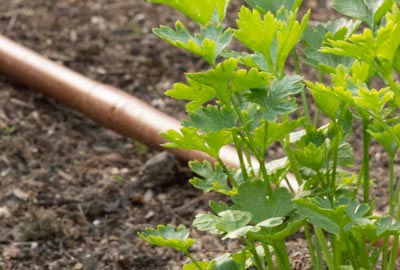
Planting Method/Tips
Parsley can be slow and variable to germinate, often taking 2 to 6 weeks or longer, and also is slow-growing in the seedling stage, usually needing 4 to 8 weeks or longer after germination to reach transplanting size. For these reasons, and because parsley germinates best at warm temperatures of 75° to 85° F, GardenZeus recommends starting seeds indoors in a bright, warm area for later transplant outdoors in daytime temperatures of 65° F to 85° F.
When transplanting, spread roots of seedlings gently outward and downward to encourage a deep, spreading root system. While some experts recommend tearing off excess roots at transplanting, at GardenZeus, we prefer to minimize damage to seedling roots during transplant. Plant slightly deeper than the level at which starts were in packs or pots, and tamp soil gently. Water immediately after transplanting.
Broadcast seeds directly outdoors when temperatures are 85° F or below, and cover with a very thin (1/8-inch or less) layer of fine soil or sand. Broadcasted seeds must be kept moist for germination, which may require misting or watering with a gentle, fine spray 2 or more times per day.
When starting parsley from seeds outdoors, you may want to grow a fast-germinating crop, such as radish, nearby. This provides a visual cue as to where parsley has been planted, and may allow you to harvest a second, faster crop in the same space during parsley's slow germination and seedling periods.
One of the best ways to grow parsley is to let a crop originally planted in fall go to seed over the following summer and naturally drop mature seeds. If the garden area where parsley drops seeds can be kept reasonably dry from summer until fall-and-winter rains, seeds will survive in and on soil. The germination inhibitors in their seed coats will naturally degrade over weeks and months. When this occurs, parsley will often sprout on its own with fall-and-winter rains or with irrigation, without putting you through the long wait and hassle of growing transplants or protecting seedlings for months. Be sure to watch for parsley sprouts in the weeks after rains, and for best harvests, provide supplemental water between rainy periods and to avoid any wilting.
Spacing
Plant parsley seeds about 1/8 to 1/4 inch deep, or broadcast seeds and cover with compost, mulch, soil, or sand to help keep seeds moist.
Parsley plants can grow surprisingly large before bolting; Italian or flat-leaf parsley plants can reach to 2 to 3 feet high and 18 inches to 2 feet wide. Curly parsley varieties are smaller, but still may reach 12 to 18 inches in height and 12 inches in width. They grow even larger when bolting.
Spacing parsley plants efficiently is trickier than with most vegetables. Seedlings grow slowly for several weeks until established; if you plant initially for final spacing, you'll have a lot of bare, unused garden space for weeks or months. To address this issue, GardenZeus recommends thinning small seedlings to 2 inches apart after broadcasting, transplanting or thinning again for early edibles as plants establish to spacing of 5 to 6 inches apart, and harvesting aggressively or thin out established plants here and there as needed to maintain reasonable spacing as plants grow in size, to an eventual possible spacing of 18 inches to 2 feet or more for mature plants.
Timelines
Parsley seeds germinate slowly and erratically due to germination inhibitors in their seed coats, and likely other factors.
2 to 6 weeks or longer to seed germination (generally faster in warm soil at 70˚ to 85˚ F and slower in cool or cold soil at 55° F or below).
Transplant seedlings 6 to 10 weeks after germination.
Early harvest of thinned plants may begin within 5 to 10 weeks of germination.
45 to 90 days to harvest of leaves from established plants.
70 to 140 days from germination to harvest of mature plants, depending upon variety and growing conditions.
Pollination Needs/Tips
Because we eat the leaves and roots of parsley plants, we prefer slow flowering (slow bolting), and are not concerned with pollination unless saving seeds.
Interplanting/Companion Planting
Parsley is traditionally planted with asparagus and tomatoes. During warm-to-hot spring and summer weather, parsley will benefit from being planted among larger tomatoes or corn plants that provide partial shade, especially during hot afternoons.
GardenZeus recommends not planting parsley with carrots, celery, or parsnips, or with its other garden relatives including angelica, anise, caraway, chervil, coriander and cilantro, cumin, dill, fennel, and lovage; and also avoiding planting any of these related plants in soil where any other relative of parsley, like carrots, parsnips, celery, or coriander, was grown in the prior season.
Nutrient/Amendment/Fertilization Needs/Tips
In previously cultivated soils with moderate organic matter, parsley needs little supplemental fertilization other than nitrogen. GardenZeus generally does not recommend fertilizing parsley other than with nitrogen unless you know what is lacking in your soil after completing a lab soil test.
Unless your soil is already high in nitrogen, GardenZeus recommends adding nitrogen in the form of diluted urea or a cup of chicken manure diluted in 4 gallons of water (half cup if fresh manure) and mixed thoroughly after seedlings are 1 to 1.5 inches tall and about once per month thereafter until they are well established and harvest of leaves begins, after which modest levels of nitrogen can be applied every 2 to 3 weeks. Adding too much nitrogen may result in lush, high-carbohydrate leaves that attract insect infestation.
Mulching
Use a quarter-inch of fine mulch for small starts under 2 inches in height; increase to half-an-inch or more of fine to medium mulch after plants are 6 to 10 inches tall. Avoid covering root crowns or stems of parsley with organic mulch, as this may encourage diseases.
Pruning/Cutting Back/Pinching/Separating
Parsley plants may require many successive thinnings during their slow growth from germination to maturity. To extend harvest over weeks to months, cut only a small portion of leaves, no more than 15% to 20% of the plant's total leaf surface, at one time. You may wish to pinch or harvest very small numbers of leaves frequently to maintain compact and attractive plants. When harvesting sections of established plants, use proper pruning practices, such making cuts at nodes with pruning shears to encourage future desirable growth.
Propagating
From seeds. GardenZeus generally recommends open-pollinated, untreated, organically grown seeds. Parsley transplants well while in the seedling stage. It cannot be successfully divided, and does not transplant well after establishment due to its long, single tap root. It may be possible to root parsley cuttings, but resulting plants may lack vigor and tend to bolt.
Container Gardening
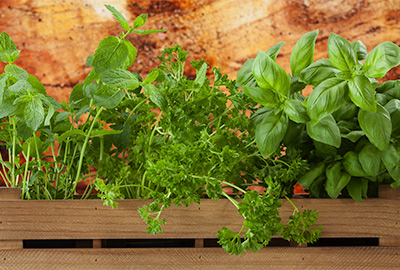
Leaf parsley is well-suited to growing in containers, and often has fewer problems in containers than many other vegetables. Both flat-leaf and curly parsley varieties can be grown in containers, and growing parsley in containers allows the added benefit of moving pots into sun during short winter days and into afternoon shade during spring heat waves or hot afternoons. Pots tend to dry out more quickly than garden beds, so be sure to provide sufficient water to parsley to prevent wilting. Wet soil is also an issue for parsley; use containers and soil that drain well. GardenZeus recommends container depth of at least 12 inches for Italian or flat-leaf parsley, and at least 8 to 12 inches for curly parsley.
Avid chefs may want to place containers of parsley close to the kitchen door for easy harvest with kitchen shears and rapid insertion in their latest culinary creation.
If growing parsley in larger pots or containers mixed with other herbs, select companions that are not closely related to parsley, such as thyme, basil, oregano, and mint.
Dwarf parsley varieties are particularly recommended for containers. Extra Curled Dwarf may be the best variety for smaller containers, with its especially attractive leaves and unusually good flavor for a curled variety.
Seasonal Care
Parsley germinates best at warm temperatures of 75° to 85° F; however, parsley grows best during cool-to-warm weather of 65° to 85° F. Parsley can be slow and variable to germinate, often taking 3 to 6 weeks or longer, and also is slow-growing in the seedling stage, usually needing 4 to 8 weeks or longer after germination to reach transplanting size. Because of its slow and variable germination, and its tolerance of transplanting, you may wish to start seeds indoors under controlled temperatures for later transplant outdoors in optimal temperatures.
Parsley generally tolerates short and overnight frosts, but often bolts in longer days and/or warm-to-hot temperatures. Harvest entire plants as soon as seed stalks appear as leaves will become bitter, often rapidly, after bolting.
How to Harvest
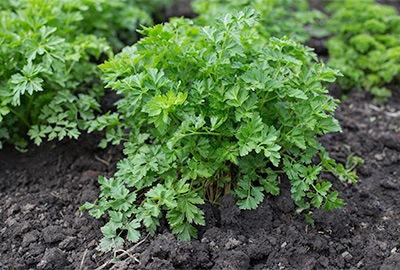
Leaves and young stems of parsley can be harvested at any time after they reach a desired or reasonable size for eating. Use a sharp knife or garden scissors to cut individual leaves or stem sections at nodes, generally from the outside of the plant or to thin competing stems; or cut entire young plants at the main stem.
To maximize total yield, GardenZeus recommends that you wait to harvest parsley until flat-leaf varieties are at least 10 inches tall and curly varieties are at least 6 inches tall or wide. If you wish to harvest parsley leaves throughout the growing season and still have a sizable plant to harvest at maturity, remove no more than 15% to 20% of any plant's total leaf surface at one time or over a period of 2 to 3 weeks. Harvesting individual leaves while parsley is still in the seedling stage may further delay its already slow establishment. Overharvesting will significantly slow growth of new leaves because the plant is using leaf surfaces to capture the energy needed to grow new leaves.
Some herbs tend to become stronger in flavor with successive cuttings, and many sources claim that parsley's flavor improves after repeated harvest.
Harvesting Tips
Parsley flavor and essential oils may be strongest in smaller and younger plants, and in younger, partly shaded leaves on established plants. GardenZeus generally recommends harvesting culinary and aromatic herbs mid-morning on cloudy or cool days when possible to maximize quality and flavor of leaves, with the second choice being earlier in the morning before temperatures become warm.
In fertile soil with sufficient nitrogen, and when plants are healthy and well established, parsley regrows well after aggressive cutting.
What Commonly Goes Wrong
Long, erratic, and variable germination with slow growth during seedling stage: Ah, the potential trials and tribulations of growing parsley from germination to establishment. Seeds often take 3 to 6 weeks or longer to germinate, and starts may take 2 to 3 months or longer to leave the seedling stage. The home garden is often a wild and dangerous environment for germinating seeds and tender sprouts, and much can go wrong during such a long establishment period, including loss of interest on the part of the gardener, or even forgetting that parsley was ever planted. Common problems during parsley's long germination and seedling stage include loss of plants to damping off pathogens (see GardenZeus section "Common Diseases") and birds. Many insects avoid parsley because of its pungency, but cutworms don't seem to mind, and can devastate parsley crops at the seedling stage. It's important to maintain consistent and progressively deeper watering but not wet soil conditions for parsley during its long establishment.
Bolting: Parsley generally does not bolt over winter if planted in fall in mild winter areas of California, but may do so in response to unusually cold conditions or in cold areas of California. Parsley more commonly it bolts if exposed to a warmer period or heat wave over winter, then an especially cold period, or in the hot weather that often begins in late spring or summer in many portions of California. Parsley may also bolt as a result of water stress or repeated wilting, in general in response to hot or cold weather, or naturally as a result of its biennial reproductive cycle. There is nothing that can be done to reverse or stop bolting once it begins. Flowering parsley provides food for many beneficial insects, so this might not be a problem in the larger plans of an insect-friendly gardener, but it is a problem for your harvest, and will result in bitter or unpalatable leaves.
Slow growth, lack of vigor, small plants, production of few or small roots or leaves, yellowing leaves, dried-out or brown leaves: These common symptoms may result from soil pH that is too high or too low, compacted soil, alkaline soil, overwatering, underwatering, irregular watering, poor drainage, warm or hot weather, lack of soil nitrogen, other soil nutrient deficiencies, or a combination of these. May also be the result of hot weather, wind, or other environmental and abiotic factors. Burned leaf tips may also result from overfertilizing, sodic soils, or soluble salts in soils. Leaves naturally turn yellow and brown when plants go dormant.
Not a Problem
Slow germination and slow seedling growth (with special commentary by GardenZeus honorary and promptly retired Captain Darren Butler): Ahoy there, me lads and lassies. Here's the rub, me brave gardeners: growing parsley may be smooth sailing, with only a spot or two of grief for the most of ye, except that bit about starting them seeds. Aye, and that other bit about how parsley puts down a good root before it does much of anythin' else, so it can drive an honest scoundrel about mad in its blasted shyness to do much aboveground for a good long time. Long enough, I'll say, to shiver your timbers, and that's how I sees it from my gardening quarterdeck. If ye are a new gardener or just getting your garden legs, so to say, ye be wise to embark upon ye maiden parsley voyage with a trove of purchased seedlings, and leave the seed-sprouting to the stout-hearted, the wise, and the mad. Drop anchor at "Recommended Varieties/Cultivars" and "Buying/Selection Tips," above, to begin the tale at the good part, with transplanting, where the action starts.
If ye are in it for the adventure of it all, or don't mind ye a slow start to your gardening tales and a bout o' choppy seed sproutin', so to say, turn ye a deaf ear to them whispered rumors of wailing, teeth gnashing, and the other horrors of parsley germination and keep ye hearts brave. It can be done, with a will now, me hearties, and like as not, a good crop of parsley leaves will be waving in the breeze on your garden decks . . . but only in parsley's own good time.
For the non-seafaring gardener (which you can reasonably conclude you are if the above made little or no sense), refer to GardenZeus section "Getting Started" for tips on germinating parsley.
Common Diseases
Damping Off: Common soilborne fungi and other pathogens that may suddenly kill smaller seedlings and starts. Occurs most commonly in cool, damp soils.
Mildews: Powdery and downy mildew appear as a whitish circles or whitish layers on the upper or lower surfaces of leaves, yellowing or dead spots, or pale-green or yellow leaf sections, and may be mistaken for other problems, such as nutrient deficiencies. Powdery mildew is a more common problem in many portions of California zone than downy mildew. Avoid wetting foliage when watering. Some mildews can be discouraged using a nontoxic homemade spray of one tablespoon each of baking soda and tea tree oil per quart of water, shaken vigorously and regularly as applied via spray bottle. Mildews are often difficult to control and are best managed through prevention and good cultural practices, such as planting resistant varieties, planting in areas with good air circulation, keeping foliage dry, less-frequent irrigation at soil level rather than overhead or from sprinklers, encouraging biologically active "living" soil that will support strong plant immune systems, and rotating crops. Mildews are often not fatal and parsley may produce reasonable yields of fresh uninfected leaves despite ongoing infections on older leaves.
Leaf blight and leaf spot: These are caused by Stemphylium and Septoria fungi, and are generally a more serious issue for commercial parsley farming than in home gardens. Inspect transplants to be sure that foliage is healthy and free of disease. Keep foliage dry and avoid watering from overhead or with sprinklers. Try the natural tea-tree oil spray described above for mildews.
Common Pests
Birds may eat garden parsley, especially younger plants. Parsley produces a biochemical called "furanocoumarin," likely as a protective mechanism, which discourages most insect and mammalian pests, although rabbits, deer, and others mammals will eat it sporadically or if hungry enough.
Various cutworms and caterpillars will attack parsley, especially at the seedling stage. Spider mites produce fine webs and yellow, white, or reddish spots on leaves during warmer weather in late spring and summer.
Special Care
Pregnant women may wish to consult with their doctors before consuming more than small amounts of parsley.
Special Info
If you see green caterpillars with black-and-yellow mottled stripes on your parsley, and you like butterflies, this may be cause for celebration; they may be caterpillars of anise swallowtail butterflies. These caterpillars are among the few that feed on parsley plants at maturity. Many gardeners welcome sharing their parsley with this beautiful butterfly species, and butterfly gardeners plant parsley and its relatives specifically as hosts for anise swallowtail caterpillars. Anise swallowtail caterpillars generally appear at low population levels and rarely cause major or long-term damage to parsley in home gardens, as it produces new leaves over long periods or until bolting.
Ancient Greeks laid sprigs of parsley on graves and decorated tombs with wreaths of parsley. The ancient historian, Plutarch, recorded the story of a Celtic ruler turning away a much larger, invading Greek army by sending hundreds of donkey loaded with parsley toward the advancing Greeks, who fled at the sight of so much parsley because they associated it so strongly with death.
Sustainable Landscaping Tip
One of the best ways to grow parsley in California is to let a crop go to seed and naturally drop mature seeds. If the garden area where parsley drops seeds can be kept reasonably dry from summer until fall-and-winter rains, seeds will survive in and on soil. The germination inhibitors in their seed coats will naturally degrade over weeks and months. When this occurs, parsley will often sprout on its own with fall-and-winter rains or with irrigation, without putting you through the long wait and hassle of growing transplants or protecting seedlings for months. Be sure to watch for parsley sprouts in the weeks after rains, and for best harvests, provide supplemental water between rainy periods and to avoid any wilting.
Parsley naturalizes well in many areas of California, which is unsurprising as it is native to the Mediterranean, and is one of the best and easiest, multiple-use culinary and medicinal herbs for a permaculture or sustainable garden in your area. When it germinates on its own, it tends to be much more drought tolerant, and in fertile soil with reasonable winter rains, will often put down a deep taproot that allows it to survive and produce a reasonable yield of leaves well into spring or even summer with little or no irrigation. Parsley attracts and feeds many beneficial insects, especially when it flowers.
Advanced Tip
If growing outdoors for saving seeds, insects, including bees, are effective pollinators. Different varieties of parsley readily cross-pollinate to generally produce inferior plants for harvest and seed saving in the next generation. If saving seeds, allow one variety of parsley only to flower in your garden, and if there might be other gardeners in your area growing parsley, you may need to hand-pollinate with a small paintbrush and tie off hand-pollinated flowers onside a small paper pag to prevent cross-pollination with other varieties and maintain varietal integrity. As a biennial, parsley will generally go to seed in late spring or summer when planted the prior fall or winter.
Preservation, Storage, and Use
As with most garden herbs, parsley is best used fresh from the garden. If stored in a damp cloth or cotton towel in the refrigerator, it will last several days to a week or longer, and it stores reasonably well for about a week in a plastic bag in the produce drawer. For extended shelf life in the refrigerator, cut stems with a sharp knife and pack snugly into a jar or glass (such as a wide-mouth 2-pint glass canning jar) with about an inch of water, cover with a plastic bag, and seal off the bag with a clip, rubber band, or other tie halfway up the jar. Parsley stores well for 1 to 3 weeks using this method.
Parsley is sensitive to ethylene gas, so when placing your parsley in your refrigerator, take care to place it far away from your ethylene-producing fruit.
For extended preservation, parsley can be frozen or dried. Freezing parsley preserves flavor better than drying. Freeze whole, chopped as ice cubes or in bags with air removed, or pureed as ice cubes. Coarsely or finely chopped parsley can easily be preserved as ice cubes; pack an ice cube tray with chopped parsley and top off cubes with water. This method minimizes freezer burn and provides convenient blocks of parsley for use in cooking or for small servings. Cubes can be added to soups and stews, or thawed to recover whole leaves.
Before freezing, GardenZeus recommends blanching parsley in boiling water for 30 seconds to 2 minutes, until the green color of the parsley brightens, then immerse in ice water to cool quickly and prevent overcooking. Blanching softens leaves and stems, which makes them easier to work with when preparing for freezing, and helps to preserve nutrition and flavor. Remove air from freezer bags using a vacuum sealer or manually with a straw to minimize freezer burn. GardenZeus recommends using frozen parsley within 60 days, but flavor and quality may be reasonable for longer periods.
Dried parsley loses flavor but has the benefits of not requiring a freezer and being immediately available for use without thawing. GardenZeus recommends drying parsley in a food dehydrator, or air drying for 2 to 4 weeks spread thinly on mesh, screens, or trays. Turn leaves over at least once per day for the first several days to prevent rotting or molding. Parsley can also be dried hanging in bunches, in a conventional oven by baking in trays for a few hours at 160° to 170° F, or in the microwave by heating leaves for 30 to 60 seconds or longer at a time, allowing them to cool, and repeating until dry. Once dry, store in an airtight container. Parsley that is not thoroughly dry will spoil or mold. GardenZeus recommends using frozen parsley within 90 days, but flavor and quality may be reasonable for longer periods.
Parsley is used in seasoning and garnishing. It is popular in many soups and sauces, and is frequently added to soups or stews at the end of cooking to give a fresh taste and finish the dish. When mixed with garlic and chopped lemon zest, parsley becomes gremalota, an Italian garnish used with grilled chicken or braised veal or lamb.
Parsley provides many proven and presumed benefits beyond freshening breath. It contains antioxidants, such as beta-carotene; minerals; dietary fiber; folic acid; and vitamins, particularly C and K. It is a low-calorie food, with about 36 calories per 100 g of fresh leaves, and with zero cholesterol and fat.